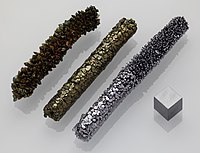
Photo from wikipedia
Bioremediation of arsenic (As) pollution is an important environmental issue. The present investigation was carried out to isolate As-resistant novel bacteria and characterize their As transformation and tolerance ability. A… Click to show full abstract
Bioremediation of arsenic (As) pollution is an important environmental issue. The present investigation was carried out to isolate As-resistant novel bacteria and characterize their As transformation and tolerance ability. A total of 170 As-resistant bacteria were isolated from As-contaminated soils at the Kangjiawan lead–zinc tailing mine, located in Hunan Province, southern China. Thirteen As-resistant isolates were screened by exposure to 260 mM Na2HAsO4·7H2O, most of which showed a very high level of resistance to As5+ (MIC ≥ 600 mM) and As3+ (MIC ≥ 10 mM). Sequence analysis of 16S rRNA genes indicated that the 13 isolates tested belong to the phyla Firmicutes, Proteobacteria and Actinobacteria, and these isolates were assigned to eight genera, Bacillus, Williamsia, Citricoccus, Rhodococcus, Arthrobacter, Ochrobactrum, Pseudomonas and Sphingomonas. Genes involved in As resistance were present in 11 of the isolates. All 13 strains transformed As (1 mM); the oxidation and reduction rates were 5–30% and 10–51.2% within 72 h, respectively. The rates of oxidation by Bacillus sp. Tw1 and Pseudomonas spp. Tw224 peaked at 42.48 and 34.94% at 120 h, respectively. For Pseudomonas spp. Tw224 and Bacillus sp. Tw133, the highest reduction rates were 52.01% at 48 h and 48.66% at 144 h, respectively. Our findings will facilitate further research into As metabolism and bioremediation of As pollution by genome sequencing and genes modification.
Journal Title: World Journal of Microbiology and Biotechnology
Year Published: 2018
Link to full text (if available)
Share on Social Media: Sign Up to like & get
recommendations!